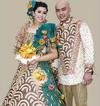Philippines
 Barong Tagalog is the official national garment in the Philippines. This male shirt (or rather garment for the upper body, as it’s not really a shirt) was originally made from pineapple fabric called “piña” (pineapple fibers are woven into cloth). This menswear has a centuries-old history and originates from the local aboriginal attire. Unlike many folk garments around the world, Barong Tagalog is still worn by the Filipino men in the 21st century. And the outlanders still fall in love with it because it’s not only pretty but also very comfy in the tropical climate.
Barong Tagalog is the official national garment in the Philippines. This male shirt (or rather garment for the upper body, as it’s not really a shirt) was originally made from pineapple fabric called “piña” (pineapple fibers are woven into cloth). This menswear has a centuries-old history and originates from the local aboriginal attire. Unlike many folk garments around the world, Barong Tagalog is still worn by the Filipino men in the 21st century. And the outlanders still fall in love with it because it’s not only pretty but also very comfy in the tropical climate.
- Details
- Category: Philippines
- Hits: 18434
 The culture of the Philippines is rich and diverse. Today, we’ll talk about the traditional clothing of the Philippines and, in particular, about each garment separately. Let’s find out what did the Filipinos wear in the past and which folk garments they prefer today. Also, we’ll touch upon such topics as the traditional attire of Filipino Muslims, local tribal outfits, and other interesting folk clothes.
The culture of the Philippines is rich and diverse. Today, we’ll talk about the traditional clothing of the Philippines and, in particular, about each garment separately. Let’s find out what did the Filipinos wear in the past and which folk garments they prefer today. Also, we’ll touch upon such topics as the traditional attire of Filipino Muslims, local tribal outfits, and other interesting folk clothes.
- Details
- Category: Philippines
- Hits: 133434
 The Tboli people who live in the Philippines have their own very curious and even a little bit odd for an outlander, traditions. For instance, they create their traditional embroidery and weaving patterns not in their mind, as everybody else does, but in their dreams. The Tboli people believe that the design must come to the craftswoman in her dream. And then, she wakes up and draws or keeps in mind the pattern, which she will embody in her work afterward. No other ethnic group in the world has similar traditions.
The Tboli people who live in the Philippines have their own very curious and even a little bit odd for an outlander, traditions. For instance, they create their traditional embroidery and weaving patterns not in their mind, as everybody else does, but in their dreams. The Tboli people believe that the design must come to the craftswoman in her dream. And then, she wakes up and draws or keeps in mind the pattern, which she will embody in her work afterward. No other ethnic group in the world has similar traditions.
- Details
- Category: Philippines
- Hits: 27327
 In the Philippines, there is a curious ethnic group – the Tboli people. They have beautiful traditional costumes, decorated with embroidery, beading, woven patterns, and extraordinary jewelry pieces. Let’s have a look at their folk outfits and also find out how some items of their clothes are made. Another interesting part of this article is an interview with Tboli craftswomen who will talk about their cultural peculiarities, the tnalak fabric – historically made on the island, and the craft of weaving in the Philippines.
In the Philippines, there is a curious ethnic group – the Tboli people. They have beautiful traditional costumes, decorated with embroidery, beading, woven patterns, and extraordinary jewelry pieces. Let’s have a look at their folk outfits and also find out how some items of their clothes are made. Another interesting part of this article is an interview with Tboli craftswomen who will talk about their cultural peculiarities, the tnalak fabric – historically made on the island, and the craft of weaving in the Philippines.
- Details
- Category: Philippines
- Hits: 104388
 Folk dance clothing tells a lot about the culture and traditions of a country. In the Philippines, there is a dance called “singkil” that shows us the traditional costumes of the Maranao people and their local folklore. It is a tiny part of the Filipino clothing culture but nevertheless, a very significant, colorful, and bright part. The dance itself is beautiful and the dancers’ outfits make it exceptional.
Folk dance clothing tells a lot about the culture and traditions of a country. In the Philippines, there is a dance called “singkil” that shows us the traditional costumes of the Maranao people and their local folklore. It is a tiny part of the Filipino clothing culture but nevertheless, a very significant, colorful, and bright part. The dance itself is beautiful and the dancers’ outfits make it exceptional.
- Details
- Category: Philippines
- Hits: 117413
 Filipino national costume is rather colorful, ornate and beautiful. Filipino people lived under the occupation of other countries for centuries. That's why their national attire was formed under the influence of different cultures and got some of their features. The US, Spain, and Japan had the biggest impact on the traditional clothing of the Philippines. But nevertheless, Filipino folk dress is very unique, authentic and even tribal, if we can say so.
Filipino national costume is rather colorful, ornate and beautiful. Filipino people lived under the occupation of other countries for centuries. That's why their national attire was formed under the influence of different cultures and got some of their features. The US, Spain, and Japan had the biggest impact on the traditional clothing of the Philippines. But nevertheless, Filipino folk dress is very unique, authentic and even tribal, if we can say so.
- Details
- Category: Philippines
- Hits: 520337

